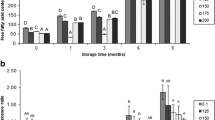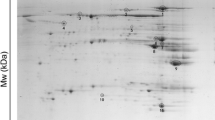Abstract
The effect of high hydrostatic pressure (HHP) treatment (150, 300, and 450 MPa for 0, 2.5, and 5 min) on total sodium dodecyl sulfate (SDS)-soluble and sarcoplasmic proteins in frozen (−10 °C for 3 months) Atlantic mackerel (Scomber scombrus) was evaluated. Proteomics tools based on image analysis of SDS-polyacrylamide gel electrophoresis (SDS-PAGE) protein gels and protein identification by tandem mass spectrometry (MS/MS) were applied. Total SDS-soluble proteins, composed in high proportion of myofibrillar proteins, were stable under pressurization treatment in terms of solubility and electrophoretic gel profiles. However, pressurization reduced sarcoplasmic proteins’ solubility, modified their one-dimensional (1-D)/two-dimensional (2-D) SDS-PAGE patterns in a direct-dependent manner, and exerted a selective effect on particular sarcoplasmic proteins depending on processing conditions. Thus, protein bands assigned to creatine kinase, fructose-bisphosphate aldolase A, glycogen phosphorylase, and β-enolase were degraded at 300–450 MPa. Additionally, the stability of triosephosphate isomerase B, phosphoglucomutase, and phosphoglycerate kinase-1 was found to be HHP-reduced when submitted at 450 MPa. HHP processing (300–450 MPa) also induced a cross-linking product formation of pyruvate kinase and two compounds derived from tropomyosin at 450 MPa. Frozen storage time of pressurized samples induced an additional lessening in protein solubility, but electrophoretic patterns were not modified. The present investigation emphasizes the higher lability of sarcoplasmic proteins under HHP treatment and the important role of these proteins in the sensory quality enhancement provided by milder HHP conditions on frozen mackerel. HHP technology is expected to boost the development of novel tailored processing approaches to tackle food quality challenges.





Similar content being viewed by others
References
Ashie, I., & Simpson, B. (1996). Application of high hydrostatic pressure to control enzyme related fresh seafood texture deterioration. Food Research International, 29, 569–575.
Ashie, I., & Simpson, B. (1998). Effects of pressurization and refrigerated storage on microstructure of fish muscle tissue. Journal of Muscle Foods, 9, 193–199.
Ashie, I., Smith, J., & Simpson, B. (1996). Spoilage and shelf-life extension of fresh fish and shellfish. Critical Reviews in Food Science and Nutrition, 36, 87–121.
Aubourg, S., Rodríguez, A., & Gallardo, J. (2005). Rancidity development during frozen storage of mackerel (Scomber scombrus): effect of catching season and commercial presentation. European Journal of Lipid Science and Technology, 107, 316–323.
Aubourg, S., Rodríguez, A., Sierra, Y., Tabilo-Munizaga, G., & Pérez-Won, M. (2013a). Sensory and physical changes in chilled farmed Coho salmon (Oncorhynchus kisutch): effect of previous optimised hydrostatic high-pressure conditions. Food and Bioprocess Technology, 6, 1539–1549.
Aubourg, S., Torres, J. A., Saraiva, J., Guerra-Rodríguez, E., & Vázquez, M. (2013b). Effect of high-pressure pretreatments applied before freezing and frozen storage on the functional and sensory properties of Atlantic mackerel (Scomber scombrus). Food Science and Technology (LWT), 53, 100–106.
Bradford, M. (1976). A rapid and sensitive method for the quantitation of microgram quantities of protein utilizing the principle of protein-dye binding. Analytical Biochemistry, 72, 248–254.
Campus, M. (2010). High pressure processing of meat, meat products and seafood. Food Engineering Reviews, 2, 256–273.
Campus, M., Addis, M. F., Cappuccinelli, R., Porcu, M. C., Pretti, L., Tedde, V., et al. (2010). Stress relaxation behaviour and structural changes of muscle tissues from gilthead bream (Sparus aurata L.) following high pressure treatment. Journal of Food Engineering, 96, 192–198.
Chéret, R., Hernández-Andrés, A., Delbarre-Ladrat, C., de Lamballerie, M., & Vérrez-Bagnis, V. (2006). Proteins and proteolytic activity changes during refrigerated storage in sea bass (Dicentrarchus labrax L.) muscle after high-pressure treatment. European Food Research and Technology, 222, 527–535.
Chevalier, D., Le Bail, A., Chourot, J., & Chantreau, P. (1999). High pressure thawing of fish (whiting): influence of the process parameters on drip losses. Lebensmittel-Wissenschaft und-Technologie, 32, 25–31.
Chevalier, D., Sequeira-Muñoz, A., Le Bail, A., Simpson, B., & Ghoul, M. (2000). Effect of pressure shift freezing, air-blast freezing and storage on some biochemical and physical properties of turbot (Scophthalmus maximus). Lebensmittel-Wissenschaft und -Technologie, 33, 570–577.
D’Alessandro, A., & Zolla, L. (2012). Food safety and quality control: hints from proteomics. Food Technology and Biotechnology, 50, 275–285.
De Felice, F., Soares, V., & Ferreira, S. (1999). Subunit dissociation and inactivation of pyruvate kinase by hydrostatic pressure oxidation of sulfhydryl groups and ligand effects on enzyme stability. European Journal of Biochemistry, 266, 163–169.
Erkan, N., Üretener, G., Alpas, H., Selçuk, A., Özden, Ö., & Buzrul, S. (2011). Effect of high hydrostatic pressure (HHP) treatment on physicochemical properties of horse mackerel (Trachurus trachurus). Food and Bioprocess Technology, 4, 1322–1329.
FAO (2007) Fishery statistics. Capture production. Yearbook 2005, 100/1, p. 262. Food and Agriculture Organization of the United Nations, Rome, Italy.
Gallardo, J. M., Carrera, M., & Ortea, I. (2013). Proteomics in food science. In A. Cifuentes (Ed.), Foodomics: advanced mass spectrometry in modern food science and nutrition (pp. 125–165). Hoboken: Wiley.
Godiksen, H., Morzel, M., Hyldig, G., & Jessen, F. (2009). Contribution of cathepsins B, L and D to muscle protein profi les correlated with texture in rainbow trout (Oncorhynchus mykiss). Food Chemistry, 113, 889–896.
Han, J.-Z., & Wang, Y.-B. (2008). Proteomics: present and future in food science and technology. Trends in Food Science and Technology, 19, 26–30.
Hendrickx, M., Ludikhuyze, L., van den Broeck, I., & Weemaes, C. (1998). Effects of high pressure on enzymes related to food quality. Trends in Food Science and Technology, 9, 197–203.
Jensen, O., Wilm, M., Shevchenko, A., & Mann, M. (1998). Sample preparation methods for mass spectrometric peptide mapping directly from 2-DE gels. In A. J. Link (Ed.), 2-D proteome analysis protocols (pp. 513–530). Totowa: Humana.
Knorr, D. (1999). Novel approaches in food-processing technology: new technologies for preserving foods and modifying function. Current Opinion in Biotechnology, 59, 81–116.
Ko, W.-C., Jao, C.-L., Hwang, J.-S., & Hsu, K.-C. (2006). Effect of high-pressure treatment on processing quality of tilapia meat fillets. Journal of Food Engineering, 77, 1007–1011.
Laemmli, U. (1970). Cleavage of structural proteins during the assembly of the head of bacteriophage T4. Nature, 227, 680–685.
Martelo-Vidal, M., Mesas, J., & Vázquez, M. (2012). Low-salt restructured fish products from Atlantic mackerel (Scomber scombrus) with texture resembling turkey breast. Food Science and Technology International, 18, 251–259.
Norton, T., & Sun, D.-W. (2008). Recent advances in the use of high pressure as an effective processing technique in the food industry. Food and Bioprocess Technology, 1, 2–34.
Ohshima, T., Nakagawa, T., & Koizumi, C. (1992). Effect of high hydrostatic pressure on the enzymatic degradation of phospholipids in fish muscle during storage. In E. Bligh (Ed.), Seafood science and technology, chapter 8 (pp. 64–75). Oxford: Fishing News Books.
Oms-Oliu, G., Martín-Belloso, O., & Soliva-Fortuny, R. (2010). Pulsed light treatments for food preservation. A review. Food and Bioprocess Technology, 3, 13–23.
Ortea, I., Rodríguez, A., Tabilo-Munizaga, G., Pérez-Won, M., & Aubourg, S. (2010). Effect of hydrostatic high-pressure treatment on proteins, lipids and nucleotides in chilled farmed salmon (Oncorhynchus kisutch) muscle. European Food Research and Technology, 230, 925–934.
Pazos, M., Pereira da Rocha, A., Roepstorff, P., & Rogowska-Wrzesinska, A. (2011). Fish proteins as targets of ferrous-catalyzed oxidation: identification of protein carbonyls by fluorescent labeling on two-dimensional gels and MALDI-TOF/TOF mass spectrometry. Journal of Agricultural and Food Chemistry, 59, 7962–7977.
Richards, M., Kelleher, S., & Hultin, H. (1998). Effect of washing with or without antioxidants on quality retention of mackerel fillets during refrigerated and frozen storage. Journal of Agricultural and Food Chemistry, 46, 4363–4371.
Rodríguez, A., Cruz, J., Paseiro, P., & Aubourg, S. (2012). Effect of a polyphenol-vacuum packaging on lipid deterioration during an 18-months frozen storage of coho salmon (Oncorhynchus kisutch). Food and Bioprocess Technology., 5, 2602–2611.
Saeed, S., & Howell, N. (2001). 12-lipoxygenase activity in the muscle tissue of Atlantic mackerel (Scomber scombrus) and its prevention by antioxidants. Journal of the Science of Food and Agriculture, 81, 745–750.
Saeed, S., & Howell, N. (2002). Effect of lipid oxidation and frozen storage on muscle proteins of Atlantic mackerel (Scomber scombrus). Journal of the Science of Food and Agriculture, 82, 579–586.
Santos, S., & Regenstein, J. (1990). Effects of vacuum packaging, glazing and erythorbic acid on the shelf-life of frozen white hake and mackerel. Journal of Food Science, 55, 64–70.
Sayd, T., Morzel, M., Chambon, C., Franck, M., Figwer, P., Larzul, C., et al. (2006). Proteome analysis of the sarcoplasmic fraction of pig semimembranosus muscle: implications on meat color development. Journal of Agricultural and Food Chemistry, 54, 2732–2737.
Teixeira, B., Fidalgo, L., Mendes, R., Costa, G., Cordeiro, C., Marques, A., et al. (2013). Changes of enzymes activity and protein profiles caused by high-pressure processing in sea bass (Dicentrarchus labrax) fillets. Journal of Agricultural and Food Chemistry, 61, 2851–2860.
Tironi, V., Le Bail, A., & de Lamballerie, M. (2007). Effects of pressure-shift freezing and pressure-assisted thawing on sea bass (Dicentrarchus labrax) quality. Journal of Food Science, 72, C381–C387.
Tironi, V., de Lamballerie, M., & Le Bail, A. (2010). Quality changes during the frozen storage of sea bass (Dicentrarchus labrax) muscle after pressure shift freezing and pressure assisted thawing. Innovative Food Science and Emerging Technologies, 11, 565–573.
Torres, J. A., & Velázquez, G. (2005). Commercial opportunities and research challenges in the high pressure processing of foods. Journal of Food Engineering, 67, 95–112.
Vázquez, M., Torres, J. A., Gallardo, J., Saraiva, J., & Aubourg, S. (2013). Lipid hydrolysis and oxidation development in frozen mackerel (Scomber scombrus): effect of a high hydrostatic pressure pre-treatment. Innovative Food Science and Emerging Technologies, 18, 24–30.
Acknowledgments
The Xunta de Galicia and the European Social Fund are thankfully recognized by the financial support of the postdoctoral “Isidro Parga Pondal” contract to M.P. The Spanish Ministry of Science and Innovation is also gratefully acknowledged for the doctoral fellowship to L. M. The authors thank Mrs. Lorena Barros and Mr. Marcos Trigo for their excellent technical assistance. This work was supported by the Secretaría Xeral de I + D from the Xunta de Galicia (Galicia, Spain) through Research Project 10TAL402001PR (2010–2012).
Author information
Authors and Affiliations
Corresponding author
Rights and permissions
About this article
Cite this article
Pazos, M., Méndez, L., Gallardo, J.M. et al. Selective-Targeted Effect of High-Pressure Processing on Proteins Related to Quality: a Proteomics Evidence in Atlantic Mackerel (Scomber scombrus). Food Bioprocess Technol 7, 2342–2353 (2014). https://doi.org/10.1007/s11947-013-1250-1
Received:
Accepted:
Published:
Issue Date:
DOI: https://doi.org/10.1007/s11947-013-1250-1




